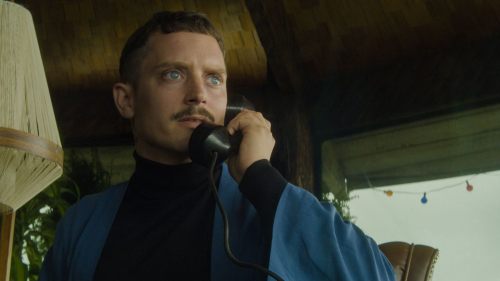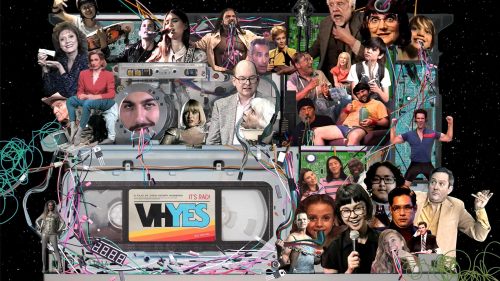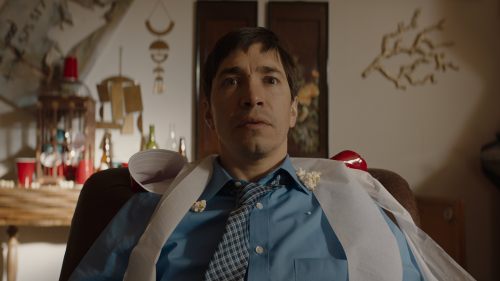Fantastic Fest Review: HOLD THE DARK Is “Snow Country For Old Men”
Jeremy Saulnier and Macon Blair have always been an indie creative duo obsessed with tribes. Their impeccable modern Western/anti-revenge yarn Blue Ruin saw white trash equivalents of the Hatfields and McCoys engaging in a generations-spanning blood feud that destroyed both broods. Green Room features a band of liberal shredders singing "Nazi Punks Fuck Off" to a compound full of white supremacists, who then trap the leather-donning thrashers in a brutal struggle where life and death hangs in the balance for all. Even Murder Party examined rather hilariously heightened cliques within the artistic community during that horror/comedy's brief, brisk runtime.
Originally pitched to producers as "Snow Country For Old Men", Saulnier and Blair's fourth go-round together (and the first where Blair is the sole credited screenwriter) is an adaptation of William Giraldi’s sparse, opaque wolf-hunting text Hold the Dark. Owning a fatalism comparable to famed author Cormac McCarthy's most brutal books, Saulnier and Blair have crafted a motion picture that continuously drives toward ferocity, as if it were the inevitable byproduct of human beings even interacting in the first place. Though it may be thematically tied to his previous pictures, Saulnier is truly flexing his visual muscles here (thanks to a much larger budget), painting a widescreen portrait of infectious evil that’s more grandiose than its rather brilliant predecessors.
With a bigger canvas (provided by streaming giant Netflix, who joined the production in its earliest stages) comes many more colors with which to shade this paranoid portrait of frontier horror. Nearly every frame of Hold The Dark combines a muted combination of greys, blacks, and earthy tones, as cinematographer Magnus Nordenhof Jønck lets us exist in a tiny Alaskan village sitting on the edge of forever, where both poor whites and indigenous peoples equally fear the creeping chill of malicious intent. Rumbling on a short wave of native mysticism, there are also elements of Greek tragedy and First Blood-style backwoods action cinema, that peaks with a tense, bloody centerpiece that would make Sam Peckinpah and Stanley Kubrick shift in their graves. Sure, it gets a little overwhelming at times, but Saulnier's ambition is enough to excuse any sort of muddled thematic moments, especially once they're followed by another instance of the Virginia filmmaker's now trademark mastery of grisly violence.
On the surface, the narrative is established as being almost as rudimentary as the rest of Saulnier's gorgeously ominous output. An epidemic of wolf attacks has recently plagued this pipeline community. The mother of the latest victim, Medora Sloane (Riley Keough), pens a letter, requesting that retired author and lupine expert Russell Core (Jeffrey Wright) come to her home and hunt the animal that took her son. Solemnly, Russell flies to this Nowheresville Hellhole, where darkness falls in the afternoon and nobody can seem to find warmth (literal or otherwise).
Smash Cut To: a soldier stationed in the Middle East (Alexander Skarsgård) catches a sniper's bullet in the neck. This wounded warrior is Vernon Sloane, father to a boy he doesn't know has been snatched by the wilderness, who returns home to discover that Medora has gone missing as well. Knowing in his gut that something's rotten in this icy shanty town, Vernon teams with fellow grieving father Cheeon (Julian Black Antelope) to track the woman through the frigid forest. In rather awful fashion, we quickly learn that Vern is something of a local, terminating legend, his particular skill set fit for a combat setting, but quickly careens out of control once he sets off on this quest to discover what truly happened to the only good thing he ever created in this world.
To reveal any further plot points would be doing potential viewers a disservice, but do know that the savagery is in no short supply (and even directly commented upon by our central “Wolfman”). Yet Saulnier and Blair seem less interested in simple motivation than they are in fashioning their film around a somewhat confounding, upsetting mystical center. Just like Blue Ruin’s hobo avenger and Green Room’s starving hardcore band, we’re presented with a guide that continues to slide into the deep end of a world they can't quite grasp, until Core's practically drowning before our eyes. Simultaneously, Vernon’s path of death and destruction reaches slasher film proportions, as the soldier dons a terrifying tribal mask and lays waste to anything that may impede his reaching Medora (who lives up to the Byronic origins of her name).
Jeremy Saulnier loves visceral, tactile violence. His movies hurt in a way few others' do (Gareth Evans comes to mind as possibly his current sole competitor). Whether it's a machete nearly lopping off a singer's arm, or a rifle's bullet practically ripping off a man's head by surprise, it's clear that Saulnier desires to show you what these awful moments actually do to a human body. In Hold the Dark, he may have delivered his finest instance of mayhem yet, with a stand-off sequence that feels like the director remaking the climactic sniper set piece from Full Metal Jacket, only with a heavy-caliber machine gun. This writer's not going to reveal precisely when it occurs, but prepare yourself for a bit carnage that's impressive by even Saulnier’s high standards.
Nevertheless, for those seeking out the instantly satisfying panicked terror of Saulnier’s previous endeavors, Hold The Dark may be a slight disappointment. The blunt elegance of his “violent colors” diptych is gone, replaced by a beautiful but hazy dread that never desires to offer up concrete explanations for anything that transpires during its stomach-turning two hour-plus runtime. Similarly, Blair’s script is sprawling instead of compact, taking Giraldi’s spartan descriptions and using them to manufacture a portentous nightmare that shifts from doom-laden set up to relentlessly violent chase film, but still never really shifts into a gear above “patiently unsettling”.
Thankfully, Core gets paired up with a local lawman (James Badge Dale), a relationship that provides a somewhat chummy balance to Vernon and Medora’s anti-human antics. Dale’s cop is one of the few sources of light (not to mention brief lightness) that exists in Hold the Dark, as he approaches the mayhem consuming his neck of the woods with unmitigated empathy. The actor has become a rather handsome, stoic figure of authority in 2018’s “warrior poet” genre subset – just check out his other two turns as small-town cops in FF titles Donnybrook and The Standoff at Sparrow Creek for further proof – and his calm, collected demeanor grants the audience (not to mention the bewildered hunter) a slight semblance of order amidst the ostensibly unstoppable one-man apocalypse.
While the movie arrives at a bit of an anti-climax (not to mention leaves one defining character element from the book regarding Vern and Medora deliberately hazy), Hold the Dark still returns to the key idea that we all run with our own packs, in one way or another. There may not be a color in this film’s title, but it's heavily reinforcing the filmmakers' old school fascinations with grudges, curses and healing connections that collectives of bonded humans carry. So, while Saulnier and Blair may be moving up in the world in terms of the scale and scope of their projects, their obsessions remain, only channeled into a rather exquisite concoction of primal existential dismay.



